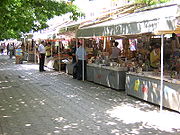
Slaveykov Square
Encyclopedia

Sofia
Sofia is the capital and largest city of Bulgaria and the 12th largest city in the European Union with a population of 1.27 million people. It is located in western Bulgaria, at the foot of Mount Vitosha and approximately at the centre of the Balkan Peninsula.Prehistoric settlements were excavated...
, the capital of Bulgaria
Bulgaria
Bulgaria , officially the Republic of Bulgaria , is a parliamentary democracy within a unitary constitutional republic in Southeast Europe. The country borders Romania to the north, Serbia and Macedonia to the west, Greece and Turkey to the south, as well as the Black Sea to the east...
. It is named after Bulgarian writers Petko
Petko Slaveykov
Petko Rachov Slaveykov was a noted nineteenth-century Bulgarian poet, publicist, public figure and folklorist.-Early years and educational activity:...
and Pencho Slaveykov
Pencho Slaveykov
Pencho Petkov Slaveykov was a noted Bulgarian poet and one of the participants in the Misal circle. He was the youngest son of the writer Petko Slaveykov....
, a father and a son. A sculpture of the two sitting on a bench is one of its main landmarks. Slaveykov Square is famous for its many book stalls.
A square called Kafene Başi is first mentioned to have existed at the modern place in 1515. A coffeehouse, a mosque and two Turkish
Ottoman Empire
The Ottoman EmpireIt was usually referred to as the "Ottoman Empire", the "Turkish Empire", the "Ottoman Caliphate" or more commonly "Turkey" by its contemporaries...
police stations were situated there.
In the 17th century, the square was an important crossroad stretching from modern Sveta Nedelya Square to Vitosha Boulevard
Vitosha Boulevard
Vitosha Boulevard is the main commercial street in the centre of Sofia, the capital of Bulgaria, which is abundant in many posh stores, restaurants and bars. It extends from the St Nedelya Square to the Southern Park...
and featured a fountain.
After the liberation of Bulgaria, the square was extended and many one and two story houses with gardens were erected on the site, one of which belonged to Petko Slaveykov, whose name the square later took.

After 1944, the automobile traffic around the square was gradually limited and it turned into a pedestrian area.
In the years following 1990, the square became a preferred place for booksellers and many bookshops emerged on it. This is probably because the Sofia City Library is at the square.

